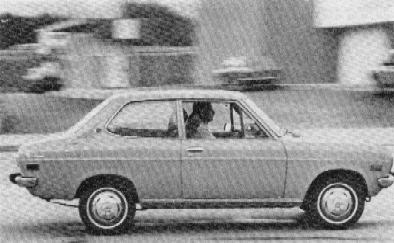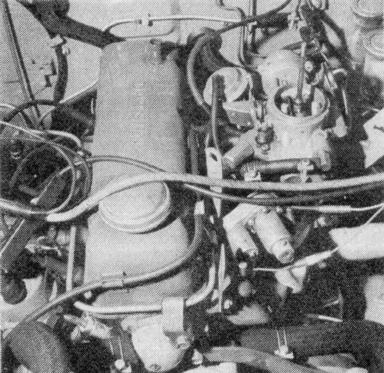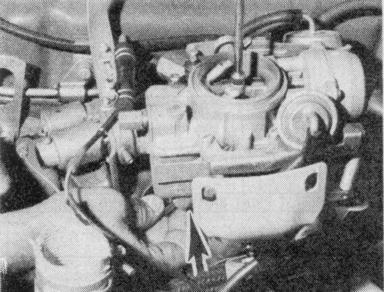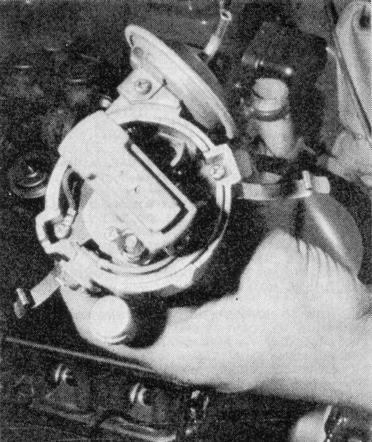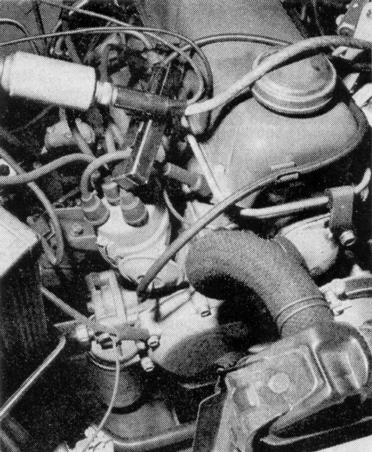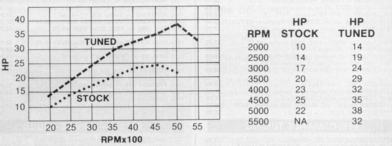UPDATE: John Geraghty passed away 27 May 2016.
SUPERTUNE: Datsun 1200
[Article from Motor Trend magazine, Nov 1973 issue pp. 142-144.]
|
SUPERTUNE: Datsun 1200 By John Christy Everyone is aware of the potential of the Datsun 510 and 610 cars, both as street machines and racers (although Datsun has stopped trumpeting its race wins to the world). There is also Baby Brother, the little 1200, also known as the 100 -- and please no comments about the 1:10 morning milk train. The 1200 is becoming equally well publicized, this time for its miserliness in the use of precious gasoline. Depending on whose tests you like, Motor Trend's or the EPA's, it is either second-best or best in the country for miles traveled on a gallon of fuel.
Stromberg-type progressive two-barrel unit found on such engines as the Subaru 1400 DL and the Honda Civic. It isn't readily apparent when you first get into the car because there is a definite detent feeling in the throttle between primary bore operation and the cutting in of the secondary throttle. As a result, it feels at first as though it were a single barrell carburetor and the detent point is all there is. A slightly stronger push on the throttle and one senses that it has suddenly developed about two more cylinders, similar in many respects to the operation of a Mazda when the secondary throttles and ports are opened.
increase in CO but little or none in HC, indicating an efficient burn. Secondary cruise was about the same as primary, indicating it was a bit lean for the added air and load. The power curve was pretty close to those of such cars as the Honda Civic, Subaru 1400 and Fiat 128, differing mainly in the higher speed ranges by being from four to five drive-wheel horsepower down which could be expected from a pushrod, non-crossflow head design. In any event the only problem we could see with the carburetion was that the secondary side was a touch on the lean side for full-load running. It also had the effect of pulling peak power down to 4500 rpm instead of the claimed 6000 or the expected 5000 rpm, as can be seen by the chart and the graph, due to leaning out at the top end.
The ignition, which carries just one set of points, was removed and placed on the strobe. The rotor and breaker plate were removed, exposing the advance weights and springs. The only change made was the replacement of secondary spring (the one that is loosest) with one from th ekit. This procedure keeps the primary part of the ignition curve standard but quickens the secondary part so that it peaks nearer the point of peak torque and just above the tip-in point of the secondary throttle. The breaker plate was reinstalled and the points set by the dwell meter to give 51-degree dwell. This part is critical and in all cases of this sort, the points should be set
by dwell rather than by guess or feeler gauge since improper point setting can negate much of the effect and also affect the car's emissions.
The ignition is of the single point set variety. The breaker plate is simple to take out and only one spring needs to be changed. It is mandatory to set point gap by dwell rather than by feeler gauge. Back on the street, the added power at the bottom end wasn't especially noticeable until 3500 rpm, though it made itself apparent by a smoother take-off. It was the secondary tip-in in the lower gears that gave the clue that something was different. The conjunction of the quickened advance and the air/fuel curve now matched better, giving a more efficent burn and the difference was one that could be felt and even seen. Getting onto freeways was no problem, other than making sure the car wasn't exceeding the traffic flow speed. Moving over into faster lanes was easier and quicker and on one hill over the Santa Monica mountains where it would formerly do about 45 in third gear, it would run up to above 55 mph, being limited mainly by the scrub-off speed in the turns. The action and feeling was nearer a well-tuned 1600cc car, such as a Colt or Big Brother 510, rather than a 1200. Mileage suffered not at all expect in the top end in secondary power, the problem being that it was no longer satisfying to remain in low cruise because booting it was such fun.
|
... Page 3 to be continued ...
Only 25
Story recap by ddgonzal
Only 25 horsepower? Yes, 25 horsepower!
Now you know how the old hp ratings were pure fantasy. The factory's 69 hp figure for the Datsun 1200 was not the relatively accurate SAE NET rating that we have now. Instead it was based on a "gross" flywheel HP ratings (for more information, see our article Overview of Datsun 1200 HP and Performance").
Compare this with the real-world Corolla 1200 rear-wheel-horsepower dyno figures:
| RPM | Standard Corolla 1200 | Buckle S Corolla |
| 4400 | 22.4 | 32.7 |
| 4700 | 24.9 | 35.8 |
| 5000 | 26.8 | 40.0 |
| 5500 | 23.6 | 41.5 |
| 6000 | 21.9 | 43.3 |
| 6300 | 15.0 | 42.8 |
26.8 horsepower! from the Corolla 1200 on the Hunter and Delbridge dynomometer.
You can also see how well the Corolla horsepower increased but more importantly the entire power band was extended into the high rpm ranges.The Corolla had probably around $1500 worth of upgrades (in today's dollars):
- head ported and polish
- extractor exhaust (tubular headers)
- carburetor adjustments
- open-element air filter
- distributor adjustments
- Fleetwing 100 petrol (high octane gasoline)
- dyno tuning
So what was all this Corolla upgrade gear good for?
| Spec | Standard Corolla 1200 | Buckle S Corolla |
| Top Speed | 87 mph | 95 mph |
| 1/4 mile | 19.3 sec | 18.5 |
| 0-60 mph | 14.4 sec | 12.9 sec |
| Fuel | 31 mpg | 32.3 mpg |
As you can see, all this work did NOT make the Corolla 1200 a fast car, but according to the testers it sounded more "savage" than the Escort GS's "prowl growl".
Baseline Tuning
Here's what you can do to Supertune your A engine:
IGNITION
- make sure the dwell is correct (49-51 degrees)
- Dwell is set every 3,000 miles per Nissan maintenance schedule
- Set total timing to 32 degrees (A12) or 34 degrees (A14/A15)
- Remove one of the distributor springs so advance occurs sooner
CARBURETOR
- Check that the vacuum advance works. This increases power at low throttle openings (great for street engines, not important for race engines)
- Ensure there are no vacuum leaks which lean out your carburetor
- Inspect the Carburetor Float. Adjust if not spot-on
These FREE processes will gain HP over the average-condition A engine.
Dyno-Tune Kit
Geraghty Dyno-Tune Kit is the brainchild of John Geraghty, who runs a small tune-up shop in Los Angeles.
Naples Daily News June 4, 1972

![[Datsun 1200 encyclopedia]](/wiki/upload/wiki.png)
